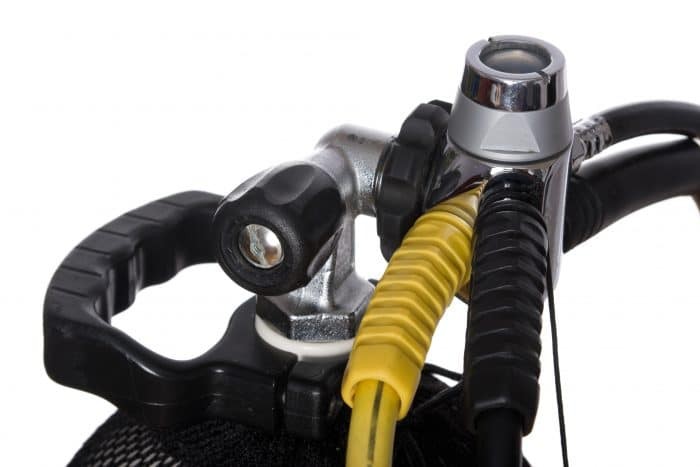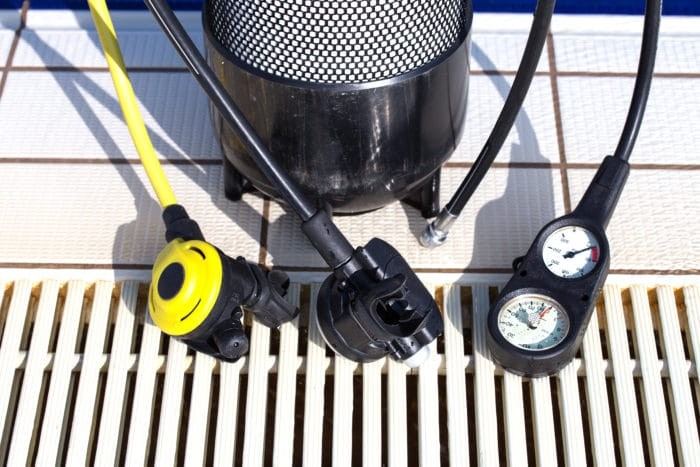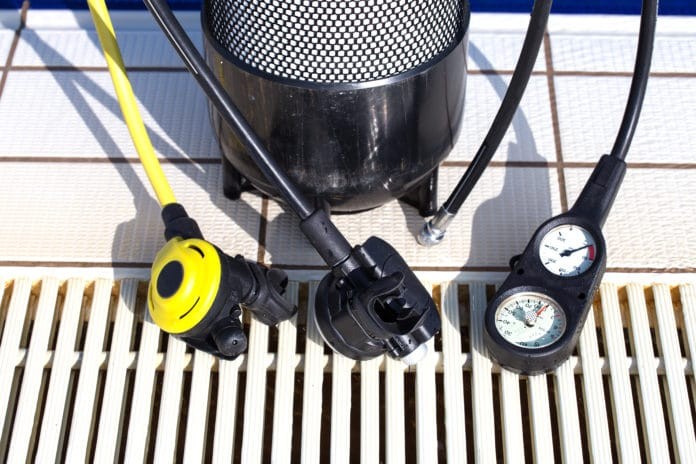As a new scuba diver, buying your first regulator is most likely the most challenging of your new gear purchases. It is not likely that you will understand the differences between the $200 regulator set and the $1,500 one. Few divers will ever use the full potential of the higher price one, and many divers will outgrow the least expensive. We have grown accustomed to calling the second stage regulator as just a regulator. However, when we set out to buy a regulator, we will likely be buying more than just the second stage. What we do purchase is a first stage regulator, a second stage regulator, an octopus, a gauge/ computer package and required hoses including a low-pressure hose for the BCD.
The Makeup of a Regulator Package

The first stage regulator is the part of the regulator assembly that attaches to the cylinder. The first stage will have multiple ports. There is one and possibly two high-pressure ports and three or more low-pressure ports. The function of the first stage is to reduce the pressure of the gas within the scuba cylinder to an intermediate pressure. You connect your regulator assembly to a full scuba cylinder with 200 bar about 3,000 psi of pressure. When you slowly open the valve, the first stage will allow that pressurized gas to pass out of the high-pressure port by a hose to your pressure gauge. It will also, reduce the pressure of the gas to about 8 to 10 bars (120 to 150 psi) port it by way of a low-pressure port to your second stage regulator.
The second stage regulator is the device that you breathe from. The purpose of the second stage is to further reduce the pressure of the gas you are going to breathe to equal the surrounding pressure. The hose from the first stage will be pressurized at that 8 to 10 bars (120 to 150 psi) intermediate pressure. If you are at 10 meters/33 feet, the pressure around you is at 2 bars/2 ATM/ 29 psi. The second stage releases the gas on demand at the pressure of your surroundings, in this example at 2 bar/ 29 psi.

The octopus is a back up second stage regulator. Primarily to be used in an out of air situation with your buddy being the one out of air. It can also be used in the rare case of a second stage regulator failure. Normally the octopus is a very basic secondary with a bright color case to be more easily seen. Divers who dive in harsh conditions often use a regulator similar to their primary as sharing a regulator become less of a priority.
Divers normally buy a console as part of their regulator package. Traditionally a depth gauge and pressure gauge were the main components of a console. A high-pressure hose from the first stage connected to the pressure gauge in the console. If there was a third instrument it was normally a compass. The availability of dive computers has offered some options. You can now purchase a console with a dive computer and a pressure gauge. An air integrated will even do away with the need for the pressure gauge.
A BCD requires a connection to a low-pressure port on the first stage so that you can auto-inflate the air bladders of your BCD. So you will have a hose available for this function.
Confusing Terms
When you are searching for the perfect regulator package you will come across some terms, you might not fully understand. They represent design features that you may or may not need.
![By Thomei08 (Own work) [CC BY-SA 4.0 (https://creativecommons.org/licenses/by-sa/4.0)], via Wikimedia Commons](https://static2.deeperblue.com/wp-content/uploads/2018/03/DIN-INT_ISO12209-2-3-700x329.jpg)
DIN Vs Yoke
These words represent two different types of valves on a scuba tank. The term DIN comes from the initials of Deutsches Institut für Normung, the German standardization institute and member of ISO. It refers to the standard that was created for high-pressure tanks. When applied to a first stage scuba dive regulator, the regulator will have a portion that screws into the high-pressure tanks valve. The thread of the connection helps secure the two pieces together. An “O” ring on the regulator will provide some protection for a metal on metal connection and seal any leaks.
The term yoke comes from a less used definition of the word that means to hold two objects together so they move as one, much like a vise or clamp. In a yoke setup, the opening of the regulator is positioned aligned with the one on the cylinder. A screw with a knob is then tightened to hold the two items together. An “O” ring located in the valve of the cylinder. When the cylinder valve is opened, additional pressure on the “O” ring causes it to expand and fill any gaps between the two parts. Yoke valves are also called international (INT) and “A” clamps.
Technical divers favor the DIN style. The DIN connection is stronger and allows no air leakage between the two parts. Also, DIN has two options 200 or 300 bar. The 300 bar valves can be used at the higher pressure. Yoke connections are only available to 200 bar. DIN first stages are generally smaller and lighter. DIN is widely used in Europe. There are adapters to allow DIN regulators to be used in Yoke style cylinders. However, these are a little bulky and can move the regulator a couple of inches closer to the back of your head.
So why get a yoke? Yoke style valves on scuba cylinders are the most common in use in the United States and the Caribbean. Most DIN valves on cylinders rated for 3,500 psi and less can accept adapters to convert from DIN to Yoke. These adapters simply screw in and are tightened with an Allen wrench. Most manufacturers include an adapter with each tank or you can pick one up cheaply at most dive shops.
Select the type you feel is best suited for your diving. If you are wrong, just buy a service kit and have your equipment tech convert it.
Balanced vs Unbalanced
Balanced and unbalanced are another set of terms that are thrown into the decision of what regulator to get. The technical differences between the two are not really important. A balanced regulator has more precision parts hence a higher price. The purpose of these extra parts is to lessen the impact of pressure. The intermediate pressure that the first stage delivers will remain constant regardless of the pressure in the cylinder until the pressure drops inside the cylinder drops to near the intermediate pressure.
The depth you are diving also has no influence on the ease of breathing. If you have an unbalance regulator as the cylinder pressure drops it will become slightly more difficult to breathe. The same is true for diving at depths. The keyword here is slight, diving at recreational levels with an average workload and you may not really beware of the difference.
The question of balanced or unbalanced applies to both the first stage and second stage. The first stage is concerned with maintaining the intermediate pressure, while the second stage is focused on keeping the same effort to inhale. You can have first staged balanced and the second stage unbalanced or both the same.
Sealed or Unsealed
Environmentally sealed regulators for recreational divers are primarily for divers that dive in cold water. The Environmental seal helps insulate the moving parts from the outside cold as well as protects them from particles in the water including ice. This helps to prevent free flows.
Diver Adjustments
Many second stage regulators have a design that is Venturi-assisted to improve airflow. It is a complicated science but boiled down to its simplest form means that the airflow is improved by the vacuum you create when you inhale. This helps make the second stage easier to breathe. However, too much assistance can cause the regulator to free flow. A common time for this is when the regulator is out of your mouth and the mouthpiece is facing the surface. Some regulators now come with a means to select if you are using the Venturi-assist or not.
Your second stage has an adjustment for the cracking or opening effort. The inhalation you need to start the flow of gas through your second stage. This is generally set by the technician when you have your second stage serviced. Some models do not have a diver adjustment for the setting. This allows you to adjust the regulator as you use it for different levels of work.
Fit and the Mouthpiece
You need to make sure that the angle the second stage is held in your mouth is comfortable. You will want to make sure you can move your head in all directions without the mouthpiece being pulled from your mouth. The mouthpiece of the second stage itself is very important. One that does not fit you will make it hard for you to relax. However, do not make a poor fit of a mouthpiece be a veto for a regulator. Mouthpieces are expendable. Find a mouthpiece that is comfortable in your mouth and simply swap it out.
Seek out advice from other divers asking their experiences. However, remember that everyone is different.
A regulator is life support equipment. So it is in your best interest to make a well-informed purchase. However, as long as you are buying an established brand from a reputable seller, your purchase will be safe and reliable.

